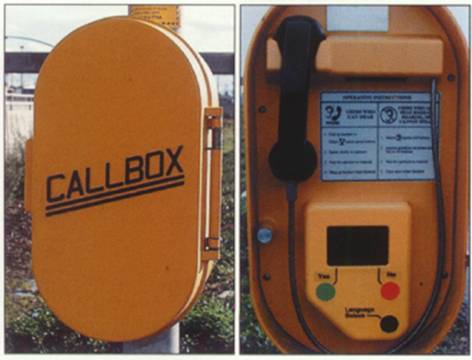[...] I support the proposed draft guidelines mandating that all emergency call
boxes in the United States be accessible to motorists with disabilities. The
requirement as drafted states that call boxes provide two-way voice
communication and must be equipped with Teletypewriters for the Deaf, (TTY's)
(proposed guideline 1110.6). To establish interactive communication with
individuals who are deaf, hard-of-hearing or have speech impairments, the call
boxes must be functionally equivalent and accessible. Accessible call boxes must
include the "Yes/No" text/graphic displays, TTY keyboards and handsets with
volume control. Detailed information is in the letter.
Please feel free to contact me [...], if you have any questions or require
further information. In addition, if you have any problem opening the attached
file, please let me know.
Thank you.
Richard Ray
I would like to take this opportunity to provide comments in reference to Draft Guidelines for Accessible Public Rights-of-Way (June 17, 2002). I support the proposed draft guidelines mandating that all emergency call boxes in the United States be accessible to motorists with disabilities. The requirement as drafted states that call boxes provide two-way voice communication and must be equipped with Teletypewriters for the Deaf, (TTYs) (proposed guideline 1110.6). To establish interactive communication with individuals who are deaf, hard-of-hearing or have speech impairments, the call boxes must be functionally equivalent and accessible. Accessible call boxes must include the "Yes/No” text/graphic displays, TTY keyboards and handsets with volume control.
I would like to take this opportunity to provide you with background information on emergency call boxes that might assist the Department of Justice and the Access Board in the preparation of the proposed guidelines to impose compliance requirements for all states (Attachment A).
In 1994, Los Angeles County Service Authority for Freeway Emergencies (LA SAFE) Advisory Committee was formed to solicit input from a group of individuals who are deaf and hard-of-hearing for the implementation of accessible emergency call boxes. Subsequently, Anthony Ivankovic (from the National Center on Deafness at California State University, Northridge), Mark Apodaca, (now Assistant Vice President of Finance for Communication Services for the Deaf (CSD), South Dakota) and I served on this committee. The committee provided technical assistance, which included: bidding; evaluation and selection of the call boxes; and development of a Public Service Announcement (PSA). I was also involved with the City of Los Angeles, Department of Transportation, where call boxes equipped with Teletypewriter for the Deaf (TTY) were installed along the Los Angeles River and Ballona Creek Bikeways in the Fall of 2000.
LA SAFE has completed the installation of more than 4,200 emergency call boxes equipped with TTY on Los Angeles County Freeways, to provide accessible emergency services to stranded motorists who are deaf, hard-of-hearing or have speech impairments (Attachment B). The accessible call boxes were also installed on lightly traveled rural roadways and on heavily traveled urban freeways as well as on local and state freeways, metropolitan, highways expressways and highways with median strips or more than four traffic lanes.
The Los Angeles call boxes include both the "Yes/No" ATM-like functions and TTY keyboards. The accessible call boxes were designed to interface with the existing 911/E911 to enable users to communicate directly with a dispatcher at the California Highway Patrol (CHP) Public Safety Answering Points (PSAPs). This is a complete system and is consistent with the ADA because the system also allows users the option of establishing two-way communication to determine the types of emergency services that are needed to avoid time delays. As a result, this could prevent further injury or death. Also, those who use TTY equipment did not have to carry their own portable TTY equipment. Each enhanced call box is identified with a sign displaying the International TTY and Phone symbols. The options, Voice Carry Over (VCO) and Hearing Carry Over (HCO) TTY calls, are available to accommodate persons who are deaf, hard-of-hearing or have speech impairments. VCO calls are for persons who are deaf or hard-of-hearing and prefer to speak for themselves. The VCO user reads the message displayed on a screen as the CHP representative types responses on their TTY equipment. This allows the VCO user to speak directly to the CHP representative. The HCO calls are for persons who are speech impaired and who can hear. The HCO user listens as the CHP representative speaks through the handset. The HCO user types back and the CHP representative reads the responses displayed on their TTY equipment. Also included, is a procedure for processing Spanish Language TTY calls to accommodate individuals whose primary language is Spanish.
The installation of functionally equivalent and accessible emergency call boxes for Los Angeles County freeways resulted from a class action lawsuit. On September 30, 1994, Alexis Kashar of Newman, Aaronson, Vanaman; David Raizman, former Executive Director; and Carol Codrington, former Director of Litigation, both from the Western Law Center for Disability Rights brought a class action lawsuit (Thalheimer) in Los Angeles County Superior Court against LA SAFE, Caltrans, Metropolitan Transportation Authority (MTA), and California Highway Patrol (CHP). The action alleged that persons who are deaf, hard-of-hearing or have speech impairments have been denied equal access to the Los Angeles County freeway emergency call boxes. Users had to either carry their own portable TTY equipment or obtain service by tapping the mouthpiece of the telephone receiver, until a light came on in the call box indicating that the help was on the way. David Raizman's successor, Eve Hill and another law firm, Munger--Tolles later joined Alexis Kashar and proceeded with the case.
On March 23, 1999, LA SAFE, MTA, and Caltrans entered into a successful settlement agreement--a big step forward for the entire community with disabilities. The agreement required the defendants to include TTY equipment in the call boxes and to make them functionally equivalent and accessible to motorists with mobility impairments. A separate settlement agreement with CHP was reached on April 8, 1999, requiring CHP to install TTY equipment to process TTY calls at every call-taking position as mandated under Title II, Section 35.162 of the 1990 Americans with Disabilities Act (ADA).
In 1998, Ventura County SAFE installed TTY equipment in all of its call boxes (Attachment C). The Orange County Transit Authority (OCTA) is in the process of implementing the functionally equivalent and accessible call boxes for the Orange County area.
For many years, the deaf and hard-of-hearing communities have fought for services that function in an equivalent manner to those of the non-TTY user community. Individuals who are Deaf and hard-of-hearing are not the only individuals who use TTY equipment. Individuals with speech impairments also utilize this equipment to communicate. Two-way communication should be made available to accommodate all individuals. The keyboard allows TTY users to quickly communicate with dispatchers or other emergency personnel to determine the types of emergency services needed. Quick responses avoid delays, which may cause further injury or death. Also, no individual should be forced to carry his/her own portable TTY equipment or to tap the mouthpiece of a telephone, when non-TTY users communicate emergency needs with dignity and ease.
The Metropolitan Transportation Commission (MTC), SAFE installed ATM-like "Yes/No” call boxes without TTY keyboards on a small percentage of their call boxes in the San Francisco Bay area on a test basis (Attachments D and E). Since 1998, MTC has been installing the “Call-Connect” light in its call boxes as they are replaced (Attachment F). The “Yes/No” function does not render call boxes functionally equivalent and accessible to individuals with disabilities. Sacramento, Riverside and San Bernardino counties in California are utilizing these inaccessible call boxes. As illustrated by the example above, very little effective effort has been made to improve emergency call boxes since the passage of the ADA.
In some states, a very basic call box is being used and when motorists need an emergency service, they are required to press a button(s) to summon help (Attachment G). When a light flashes and the tones are heard, this indicates that the message was received. In addition, there is an engraved plaque alerting call box users that the call box is not a voice communication unit, and all users are required to push buttons only for services actually needed. This type of call box is currently used in Florida and Pennsylvania and it could be perceived as functionally equivalent because there is no interactive voice communication. Therefore, this procedure also applies to individuals who are deaf and hard-of-hearing.
If the policy and procedure are implemented requiring a TTY user to only access services by pushing a "Yes/No" button or tapping the mouthpiece until a light comes on the call box without any type of interaction, these options should also apply to voice users. If a basic system, "Call-Connect" is "good enough" for individuals who are deaf, hard-of-hearing or have speech-impairments, then the basic system should be "good enough" for everyone. If the system, such as the one currently used in California, allows a voice caller to interactively communicate fully with the emergency service provider, this option should also be made available to a TTY user. Such a system should not be limited to basic communication such as "Yes/No" inquiry or, even worse, to merely having a Call-Connect light call box.
Call boxes should include both the "Yes/No" ATM-like devices, handsets with volume control and TTY keyboards, and should also include graphics for visitors who speak languages other than English. This complete system allows motorists the option to establish two-way communications. Procedures for processing Voice Carry Over (VCO) and Hearing Carry Over (HCO) TTY calls need to be included for simultaneous use of TTY and voice communication to accommodate persons who are deaf, hard-of-hearing or have speech impairments. A procedure for processing TTY calls to accommodate an individual, whose primary language is Spanish, should also be included.
The California Service Authority for Freeway Emergencies (CalSAFE) program began in 1986 and a total of 17 SAFEs have been formed, covering 31 of California's 58 counties. It was created pursuant to California Streets and Highways Code, Section 2550 et. Seq. Each county established SAFE as an independent local government agency, which is funded through the collection of a $1 fee on all vehicles registered within their respective counties (Streets & Highways 2555; Vehicle Code 9250.10). County SAFE agencies, in cooperation with two oversight agencies, California Department of Transportation (Caltrans) and California Highway Patrol (CHP), are implementing call box systems within various county boundaries.
At each county’s discretion, the distance between call boxes ranges from 1/4 mile (on heavily traveled urban freeways) to 2 miles (on more lightly traveled rural roadways). Highways with median strips or more than four traffic lanes require the installation of a call box in each direction at about the same postmile.
For several years, SAFE agencies have utilized taxpayer funds and spent many unnecessary hours evaluating call boxes for their county freeways. To date, the call boxes have not been modified in most counties. Motorists with disabilities are still unable to access emergency services, therefore these counties are not complying with Title II of the ADA.
In 1998, with the assistance of Ken Kresse of the California Center for Law and the Deaf (CalCLAD), Assembly Bill (AB) 2137 (Machado), was introduced to mandate installation of TTY equipment be included in all the SAFE’s call boxes. With opposition from CALSAFE, the author dropped the bill.
The National Association for the Deaf (NAD), the California Association for the Deaf (CAD), the California Coalition of Agencies Servicing the Deaf and Hard-of-Hearing and the California Center for Law and the Deaf (CalCLAD) are supporting such guidelines. They are advocating for full inclusion of complete TTY-equipped emergency call boxes for all state and county freeways and highways to accommodate individuals who are deaf, hard-of-hearing or have speech impairments as well as, persons with other disabilities. In addition, it is being requested that taxpayer funds be used to implement of the emergency call box program rather than on merely evaluating the call boxes for their counties.
Please feel free to contact me at [...], if you have any questions or require further information.
Sincerely,
Richard Ray
cc: Mr. Deval L. Patrick, Assistant Attorney General
United States Department of Justice
Mr. James Raggio
The Access Board
Ken Kresse, Esq., Executive Director
California Center for Law and the Deaf
Mark Apodaca, Assistant Vice President of Finance
CSD, South Dakota
Nancy Bloch, Executive Director
National Association for the Deaf
Claude L. Stout, Executive Director
TDI, Inc.
Robert Roth, Chief Executive Officer
Deaf Counseling, Advocacy and Referral Agency
Ed Kelly, Chair
California Coalition of Agencies Servicing the Deaf and Hard-of-Hearing
Russ Bye, President
California Association for the Deaf
Anthony Ivankovic
California State University, Northridge
Attachment A
PROPOSED GUIDELINES
The
Federal Guidelines mandate that if the state or local government provides
emergency services to stranded motorists by way of emergency call box, then
emergency services must also be made available for individuals with
disabilities. To establish interactive communication with individuals who are
deaf, hard-of-hearing or have speech impairments each call box must include the
"Yes/No" text/graphic display, TTY keyboard and handset with volume control.
Each enhanced call box must be identified with a sign displaying the
International TTY and Phone symbols.
In some situations, a non-voice interactive call box is utilized which requires a stranded motorist to press a button(s) to summon help. The call box will light up and have a series of tones to confirm that the message has been received. A TTY keyboard is not required to interface with a non-voice interactive call box.
The policies and procedures should also include Voice Carry Over (VCO) and Hearing Carry Over (HCO) TTY calls for simultaneous use of TTY and voice communication to accommodate persons who are deaf, hard-of-hearing or have speech impairments. Also included is a policy and procedure for processing Spanish Language TTY calls to accommodate individuals whose primary language is Spanish.
Attachment B
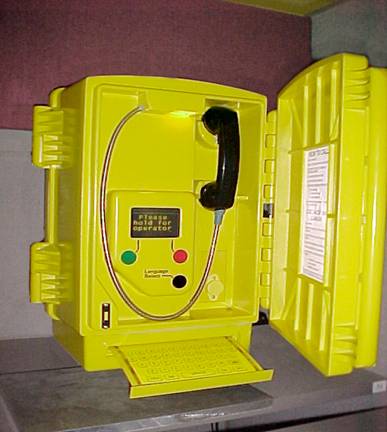
Comarco TTY Call Box
The Comarco TTY Call Box provides a horizontal TTY keyboard on a retractable shelf mounted below the call box enclosure and a display screen mounted within the enclosure to send and receive messages. This device also allows for a push button response to "Yes/No" questions. Simultaneous voice communication with the operator is also possible to provide Voice Carry Over (VCO) and Hearing Carry Over (HCO). The call box includes graphics for visitors who speak languages other than English. This call box is currently in use in Los Angeles County and Los Angeles Bikeways.
Attachment C
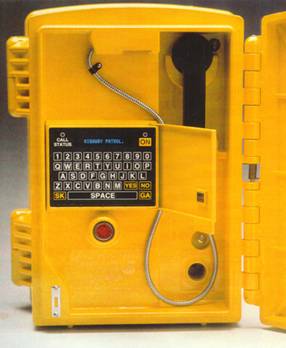
Denbridge TTY Call Box
The Denbridge TTY Call box has a vertical text telephone (TTY) keyboard and a display screen mounted within the call box enclosure to send and receive messages. Simultaneous voice communication with the operator is not possible. This call box was developed in the mid-1990s and is currently in use in Ventura County.
Attachment D
Comarco Yes/No Call Box (San Francisco Bay Area)
The Comarco Yes/No Call Box device that allows for a push button response to "Yes/No" questions and it does not include a TTY keyboard.
Attachment E
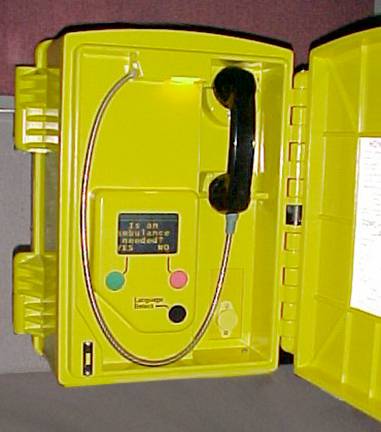
Comarco Yes/No Call Box
The Comarco Yes/No Call Box device that allows for a push button response to "Yes/No" questions and it does not include a TTY keyboard.
Attachment F
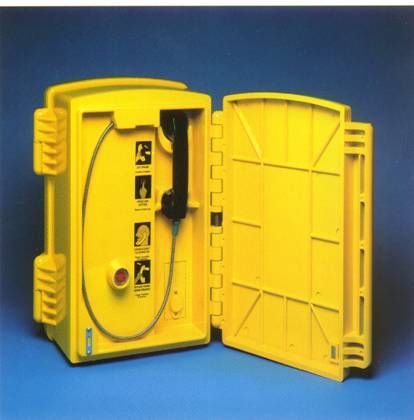
Call-Connect Call Box
The Call-Connect Call Box displays a light indicating when the call has been received at the California Highway Patrol (CHP). A voice communication with operator is also possible. A user who may not hear the operator, but can speak, will be able to speak information through the handset to the operator. An individual who may not speak may require tapping the mouthpiece of a telephone receiver to alert an operator.
Attachment G
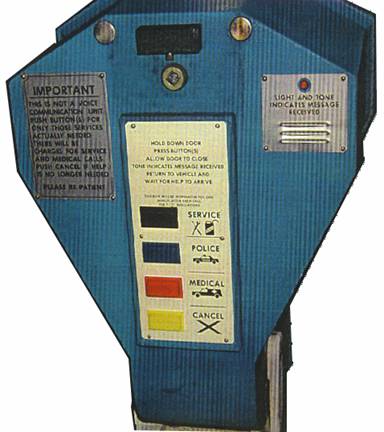
Blue Call Box
A very basic, Blue Call Box is being used and when motorists need an emergency service, they are required to press button(s) to summon help. When a light flashes and the tones are heard, this indicates that the message was received. In addition, there is an engraved plaque alerting call box users that the call box is not a voice communication unit and all users are required to push buttons only for services actually needed. This type of call box is currently used in Florida and Pennsylvania.
